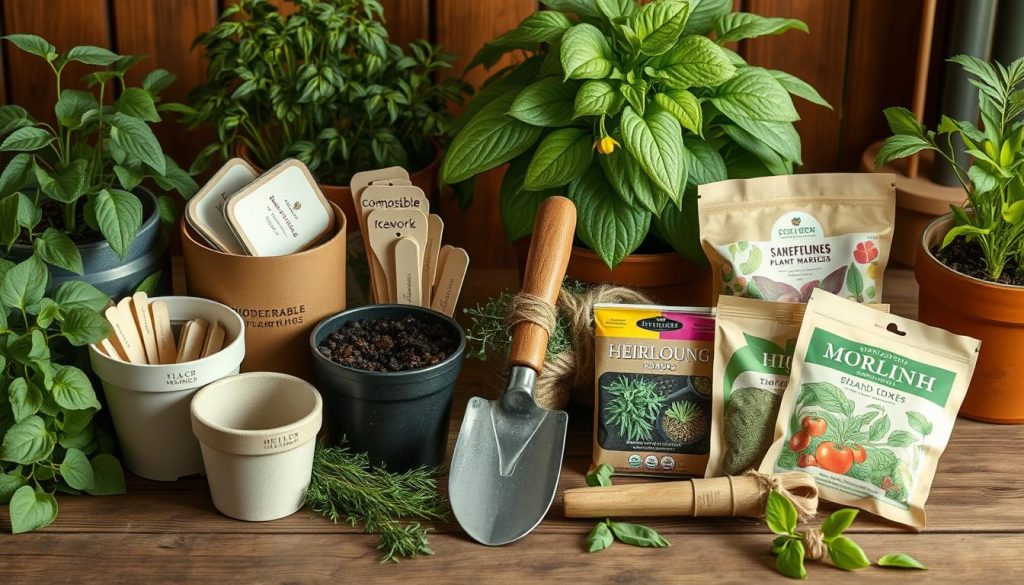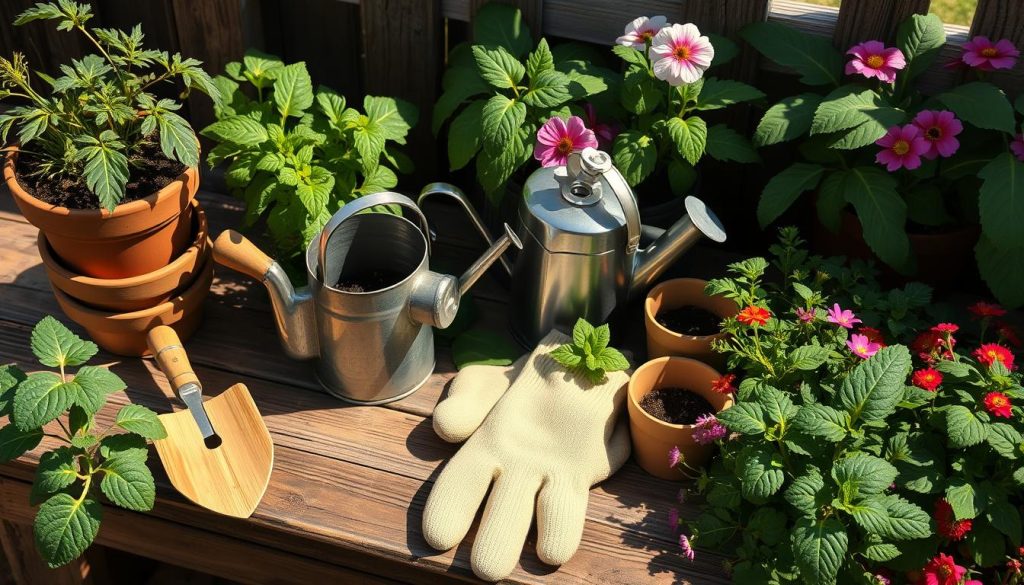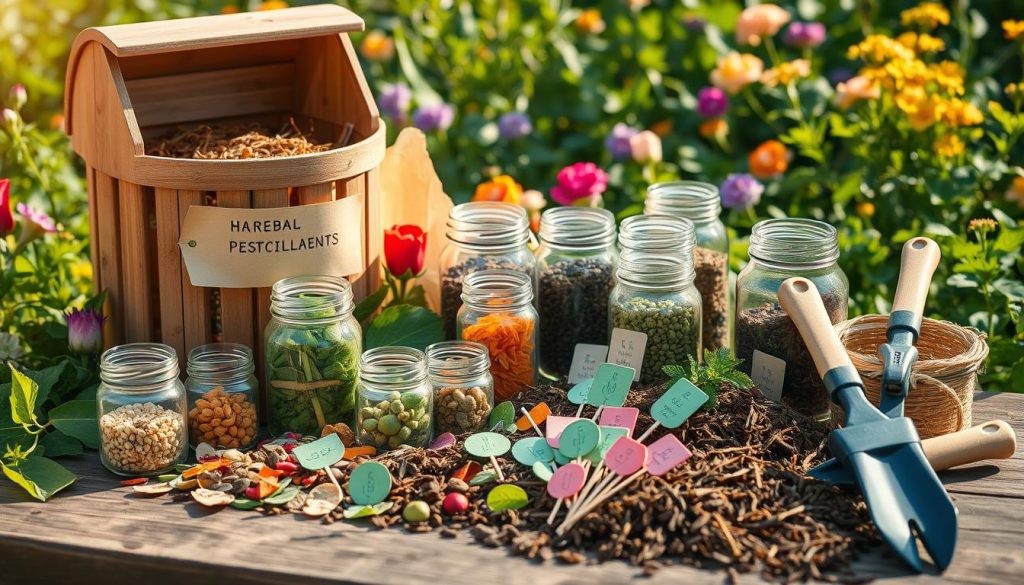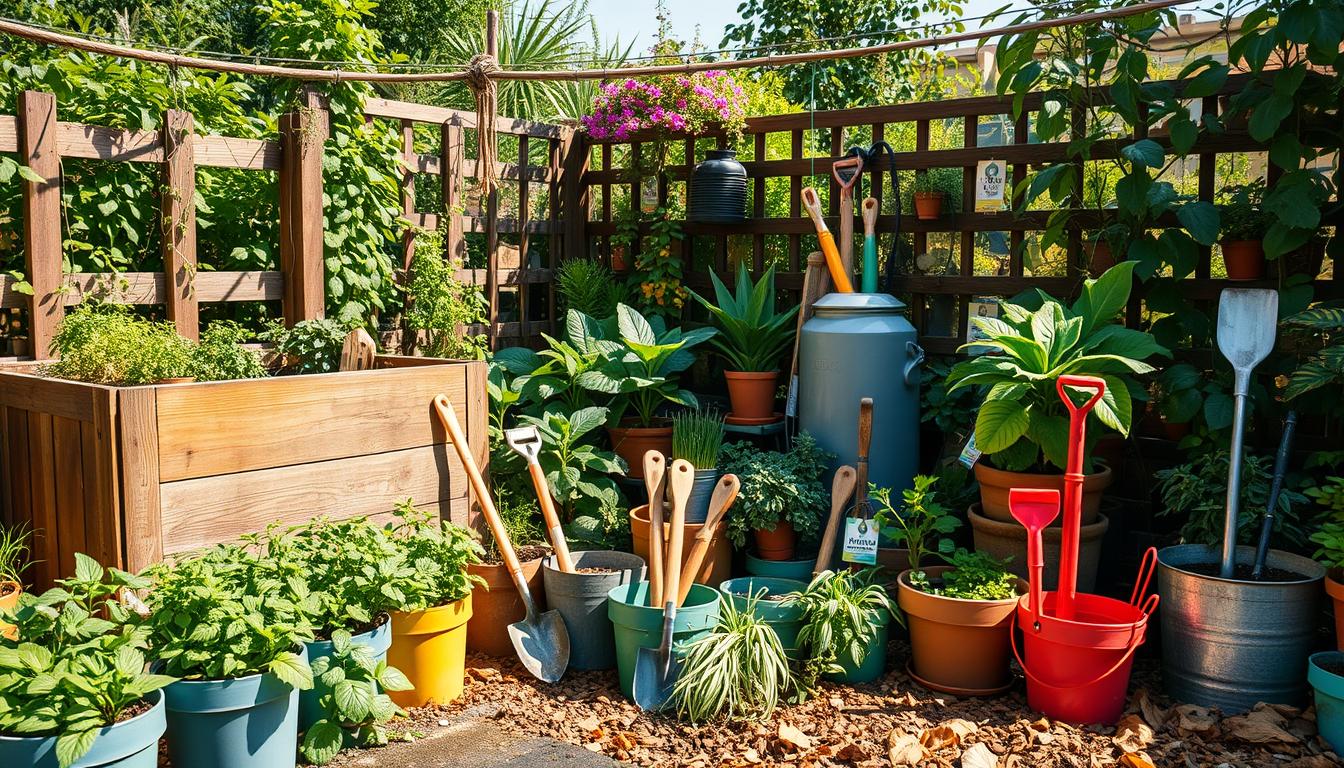As a gardener, I know how crucial it is to cut down on waste. To make our gardens green and eco-friendly, we need the right tools and products. These should be sustainable and good for the planet.
I’ll share tips on building a zero-waste gardening kit. It will have tools and products that are kind to our environment. This way, you can have a stunning garden and help the planet at the same time.
What is Zero-Waste Gardening?
As I explore gardening, I see how important it is to care for both my garden and the planet. Zero-waste gardening is a big deal now, and it’s for a good reason. Using eco-friendly tools and organic products helps reduce harm to our environment.
Zero-waste gardening means less waste and more sustainability. I use compost bins for kitchen scraps, choose natural mulch, and pick heirloom seeds without plastic. These small steps make my garden better for the earth.

Understanding the Concept
Let’s dive into what zero-waste gardening is all about. It’s about reducing waste and being green. Key practices include:
- Choosing supplies without plastic
- Using old things as planters
- Turning kitchen waste into compost
Benefits for My Garden and the Planet
Zero-waste gardening brings many benefits. For example:
- Healthier soil with organic products
- A home for pollinators and other helpful creatures
- Less harm to our planet
I’m looking forward to making my garden more sustainable. Using green tools and supplies helps the planet. Gardening becomes a way to care for our world.
Key Principles of Zero-Waste Gardening
As I work on making my garden more sustainable, I’ve learned the value of zero waste gardening. Using green products and tools helps a lot. The main idea is to cut down on waste in gardening.
Using reusable containers and composting kitchen scraps are good starts. I even use old plastic bottles as mini greenhouses. Being creative with reuse helps the planet and makes my garden better.
Reduce: Minimizing Waste in My Practices
- Use reusable containers for seeds, tools, and other gardening supplies
- Compost kitchen scraps to create nutrient-rich soil
- Repurpose old materials, such as old pallets or bricks, for garden paths or planters
Reuse: Creative Solutions for Garden Tools
Being creative with garden tools helps save money and the environment. For instance, I use old hoses as plant ties. Transforming broken terracotta pots into plant markers is another idea. This way, I make my garden more sustainable and eco-friendly.
Essential Zero-Waste Tools for My Garden
To make my garden sustainable, I need the right tools. I use compost bins and eco-friendly products to reduce waste. These tools help me create a healthier garden while being kind to the environment.
Some key zero-waste tools for my garden are:
- Compost bin: turns food scraps and yard waste into nutrient-rich soil
- Seed saving techniques: allows me to reuse seeds from previous harvests, reducing the need for new, packaged seeds
- Natural mulch: uses materials like leaves and grass clippings to retain moisture and suppress weeds, eliminating the need for synthetic mulch
By using these tools, I can make my garden more sustainable. Eco-friendly products and natural pest control methods also help keep my garden healthy.

Using sustainable tools and products benefits my garden and the environment. It helps reduce waste and supports a greener future.
Natural Pest Control Methods
Exploring zero-waste gardening has shown me the value of natural pest control. These methods cut down on chemical use and make my garden more sustainable. Organic gardening essentials like companion planting help create a balanced ecosystem.
Companion planting is a key natural pest control method. It involves growing different plants together to keep pests away and boost growth. For instance, marigolds with tomatoes can fight nematodes, and basil can enhance vegetable flavors. Using compost and natural mulch makes my garden thrive with little care.
DIY Remedies from Household Items
I’ve also found DIY remedies from household items to be helpful. These are not only effective but also save money and are good for the planet. Here are a few examples:
- Using neem oil to control pests and diseases
- Creating a soap solution to repel aphids and whiteflies
- Utilizing garlic spray to deter spider mites and other pests
By using green gardening products, I can have a sustainable garden. This garden promotes healthy plant growth and reduces waste. Natural pest control methods let me enjoy a lush garden without harming the environment.

Sourcing Sustainable Plant Materials
As I work on my zero-waste gardening, I’ve learned how key it is to find sustainable plant materials. This helps lower my environmental footprint and makes my garden more eco-friendly. I seek out products that are good for the planet and made from sustainable sources.
Using heirloom seeds is a smart choice for my garden. These seeds have been passed down for years, cutting down on the need for harmful gardening tools. Favorites include tomatoes, peppers, and cucumbers.
I also support local nurseries and community exchanges. They offer sustainable plants and eco-friendly tools, helping me grow a zero-waste garden. Here are some ways to find sustainable plants:
- Research local nurseries and community exchanges in my area
- Look for eco-friendly garden products and sustainable gardening tools
- Ask friends and family for tips on sustainable plant materials
By following these steps and choosing sustainable plants, I’ve cut my environmental impact. I urge all gardeners to find sustainable materials and use eco-friendly products. This helps us all create a greener, healthier world.
Creating a Productive Garden Space
To make a productive garden, I use zero-waste gardening essentials. These help me use resources wisely. I choose green gardening products and tools that are good for the earth. Planning my garden layout is key. I think about the space and the plants I want to grow.
Here are some tips for a productive garden:
- Use vertical gardening to save space
- Rotate crops to keep soil healthy and fight pests
- Harvest rainwater to save water
By using these methods and choosing the right tools, I create a garden that’s good for me and the planet. I also share what I know with others. This helps build a community that cares for the earth.
Engaging with My Community
Starting my zero-waste gardening journey, I’ve found that connecting with my community is key. Sharing what I’ve learned helps inspire others to garden more sustainably. I’ve joined in on plant swaps, attended workshops, and online forums.
This has opened up a world of zero-waste gardening solutions and tools. I’m excited to share these with everyone.
Building a community around eco-friendly gardening is crucial. Local events and workshops are great for learning and meeting others who care about the planet. We can all work together to make our gardens greener and our planet healthier.

